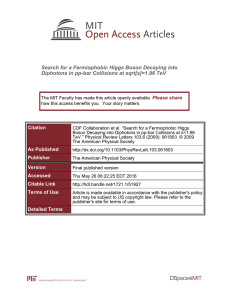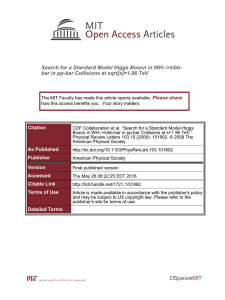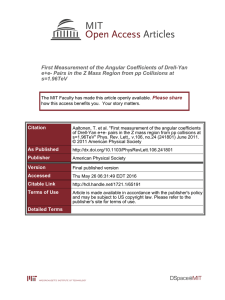Search for Top-Quark Production via Flavor-Changing Please share
advertisement
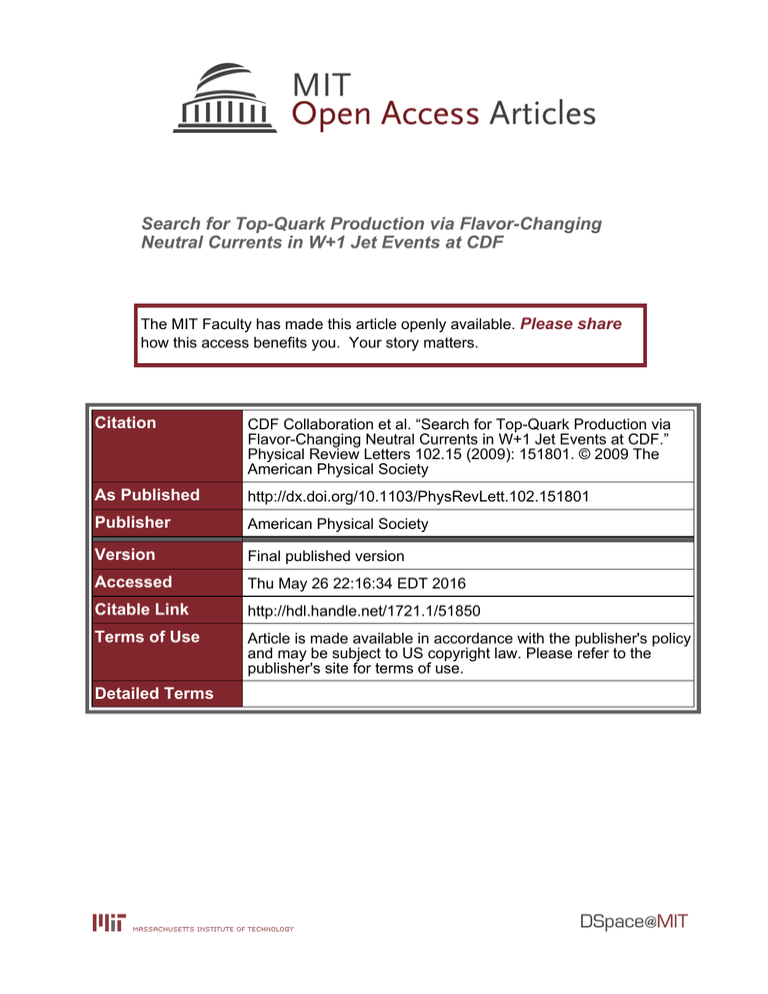
Search for Top-Quark Production via Flavor-Changing Neutral Currents in W+1 Jet Events at CDF The MIT Faculty has made this article openly available. Please share how this access benefits you. Your story matters. Citation CDF Collaboration et al. “Search for Top-Quark Production via Flavor-Changing Neutral Currents in W+1 Jet Events at CDF.” Physical Review Letters 102.15 (2009): 151801. © 2009 The American Physical Society As Published http://dx.doi.org/10.1103/PhysRevLett.102.151801 Publisher American Physical Society Version Final published version Accessed Thu May 26 22:16:34 EDT 2016 Citable Link http://hdl.handle.net/1721.1/51850 Terms of Use Article is made available in accordance with the publisher's policy and may be subject to US copyright law. Please refer to the publisher's site for terms of use. Detailed Terms PRL 102, 151801 (2009) PHYSICAL REVIEW LETTERS week ending 17 APRIL 2009 Search for Top-Quark Production via Flavor-Changing Neutral Currents in W þ 1 Jet Events at CDF T. Aaltonen,24 J. Adelman,14 T. Akimoto,56 B. Álvarez González,12,t S. Amerio,44b,44a D. Amidei,35 A. Anastassov,39 A. Annovi,20 J. Antos,15 G. Apollinari,18 A. Apresyan,49 T. Arisawa,58 A. Artikov,16 W. Ashmanskas,18 A. Attal,4 A. Aurisano,54 F. Azfar,43 P. Azzurri,47b,47a W. Badgett,18 A. Barbaro-Galtieri,29 V. E. Barnes,49 B. A. Barnett,26 V. Bartsch,31 G. Bauer,33 P.-H. Beauchemin,34 F. Bedeschi,47a D. Beecher,31 S. Behari,26 G. Bellettini,47b,47a J. Bellinger,60 D. Benjamin,17 A. Beretvas,18 J. Beringer,29 A. Bhatti,51 M. Binkley,18 D. Bisello,44b,44a I. Bizjak,31,y R. E. Blair,2 C. Blocker,7 B. Blumenfeld,26 A. Bocci,17 A. Bodek,50 V. Boisvert,50 G. Bolla,49 D. Bortoletto,49 J. Boudreau,48 A. Boveia,11 B. Brau,11,b A. Bridgeman,25 L. Brigliadori,44a C. Bromberg,36 E. Brubaker,14 J. Budagov,16 H. S. Budd,50 S. Budd,25 S. Burke,18 K. Burkett,18 G. Busetto,44b,44a P. Bussey,22 A. Buzatu,34 K. L. Byrum,2 S. Cabrera,17,v C. Calancha,32 M. Campanelli,36 M. Campbell,35 F. Canelli,14,18 A. Canepa,46 B. Carls,25 D. Carlsmith,60 R. Carosi,47a S. Carrillo,19,o S. Carron,34 B. Casal,12 M. Casarsa,18 A. Castro,6b,6a P. Catastini,47c,47a D. Cauz,55b,55a V. Cavaliere,47c,47a M. Cavalli-Sforza,4 A. Cerri,29 L. Cerrito,31,p S. H. Chang,28 Y. C. Chen,1 M. Chertok,8 G. Chiarelli,47a G. Chlachidze,18 F. Chlebana,18 K. Cho,28 D. Chokheli,16 J. P. Chou,23 G. Choudalakis,33 S. H. Chuang,53 K. Chung,13 W. H. Chung,60 Y. S. Chung,50 T. Chwalek,27 C. I. Ciobanu,45 M. A. Ciocci,47c,47a A. Clark,21 D. Clark,7 G. Compostella,44a M. E. Convery,18 J. Conway,8 M. Cordelli,20 G. Cortiana,44b,44a C. A. Cox,8 D. J. Cox,8 F. Crescioli,47b,47a C. Cuenca Almenar,8,v J. Cuevas,12,t R. Culbertson,18 J. C. Cully,35 D. Dagenhart,18 M. Datta,18 T. Davies,22 P. de Barbaro,50 S. De Cecco,52a A. Deisher,29 G. De Lorenzo,4 M. Dell’Orso,47b,47a C. Deluca,4 L. Demortier,51 J. Deng,17 M. Deninno,6a P. F. Derwent,18 G. P. di Giovanni,45 C. Dionisi,52b,52a B. Di Ruzza,55b,55a J. R. Dittmann,5 M. D’Onofrio,4 S. Donati,47b,47a P. Dong,9 J. Donini,44a T. Dorigo,44a S. Dube,53 J. Efron,40 A. Elagin,54 R. Erbacher,8 D. Errede,25 S. Errede,25 R. Eusebi,18 H. C. Fang,29 S. Farrington,43 W. T. Fedorko,14 R. G. Feild,61 M. Feindt,27 J. P. Fernandez,32 C. Ferrazza,47d,47a R. Field,19 G. Flanagan,49 R. Forrest,8 M. J. Frank,5 M. Franklin,23 J. C. Freeman,18 I. Furic,19 M. Gallinaro,52a J. Galyardt,13 F. Garberson,11 J. E. Garcia,21 A. F. Garfinkel,49 K. Genser,18 H. Gerberich,25 D. Gerdes,35 A. Gessler,27 S. Giagu,52b,52a V. Giakoumopoulou,3 P. Giannetti,47a K. Gibson,48 J. L. Gimmell,50 C. M. Ginsburg,18 N. Giokaris,3 M. Giordani,55b,55a P. Giromini,20 M. Giunta,47b,47a G. Giurgiu,26 V. Glagolev,16 D. Glenzinski,18 M. Gold,38 N. Goldschmidt,19 A. Golossanov,18 G. Gomez,12 G. Gomez-Ceballos,33 M. Goncharov,33 O. González,32 I. Gorelov,38 A. T. Goshaw,17 K. Goulianos,51 A. Gresele,44b,44a S. Grinstein,23 C. Grosso-Pilcher,14 R. C. Group,18 U. Grundler,25 J. Guimaraes da Costa,23 Z. Gunay-Unalan,36 C. Haber,29 K. Hahn,33 S. R. Hahn,18 E. Halkiadakis,53 B.-Y. Han,50 J. Y. Han,50 F. Happacher,20 K. Hara,56 D. Hare,53 M. Hare,57 S. Harper,43 R. F. Harr,59 R. M. Harris,18 M. Hartz,48 K. Hatakeyama,51 C. Hays,43 M. Heck,27 A. Heijboer,46 J. Heinrich,46 C. Henderson,33 M. Herndon,60 J. Heuser,27 S. Hewamanage,5 D. Hidas,17 C. S. Hill,10,d D. Hirschbuehl,27,x A. Hocker,18 S. Hou,1 M. Houlden,30 S.-C. Hsu,29 B. T. Huffman,43 R. E. Hughes,40 U. Husemann,61 M. Hussein,36 J. Huston,36 J. Incandela,11 G. Introzzi,47a M. Iori,52b,52a A. Ivanov,8 E. James,18 D. Jang,13 B. Jayatilaka,17 E. J. Jeon,28 M. K. Jha,6a S. Jindariani,18 W. Johnson,8 M. Jones,49 K. K. Joo,28 S. Y. Jun,13 J. E. Jung,28 T. R. Junk,18 T. Kamon,54 D. Kar,19 P. E. Karchin,59 Y. Kato,42,m R. Kephart,18 J. Keung,46 V. Khotilovich,54 B. Kilminster,18 D. H. Kim,28 H. S. Kim,28 H. W. Kim,28 J. E. Kim,28 M. J. Kim,20 S. B. Kim,28 S. H. Kim,56 Y. K. Kim,14 N. Kimura,56 L. Kirsch,7 S. Klimenko,19 B. Knuteson,33 B. R. Ko,17 K. Kondo,58 D. J. Kong,28 J. Konigsberg,19 A. Korytov,19 A. V. Kotwal,17 M. Kreps,27 J. Kroll,46 D. Krop,14 N. Krumnack,5 M. Kruse,17 V. Krutelyov,11 T. Kubo,56 T. Kuhr,27 N. P. Kulkarni,59 M. Kurata,56 S. Kwang,14 A. T. Laasanen,49 S. Lami,47a S. Lammel,18 M. Lancaster,31 R. L. Lander,8 K. Lannon,40,s A. Lath,53 G. Latino,47c,47a I. Lazzizzera,44b,44a T. LeCompte,2 E. Lee,54 H. S. Lee,14 S. W. Lee,54,u S. Leone,47a J. D. Lewis,18 C.-S. Lin,29 J. Linacre,43 M. Lindgren,18 E. Lipeles,46 T. M. Liss,25 A. Lister,8 D. O. Litvintsev,18 C. Liu,48 T. Liu,18 N. S. Lockyer,46 A. Loginov,61 M. Loreti,44b,44a L. Lovas,15 D. Lucchesi,44b,44a C. Luci,52b,52a J. Lueck,27 P. Lujan,29 P. Lukens,18 G. Lungu,51 L. Lyons,43 J. Lys,29 R. Lysak,15 D. MacQueen,34 R. Madrak,18 K. Maeshima,18 K. Makhoul,33 T. Maki,24 P. Maksimovic,26 S. Malde,43 S. Malik,31 G. Manca,30,f A. Manousakis-Katsikakis,3 F. Margaroli,49 C. Marino,27 C. P. Marino,25 A. Martin,61 V. Martin,22,l M. Martı́nez,4 R. Martı́nez-Balları́n,32 T. Maruyama,56 P. Mastrandrea,52a T. Masubuchi,56 M. Mathis,26 M. E. Mattson,59 P. Mazzanti,6a K. S. McFarland,50 P. McIntyre,54 R. McNulty,30,k A. Mehta,30 P. Mehtala,24 A. Menzione,47a P. Merkel,49 C. Mesropian,51 T. Miao,18 N. Miladinovic,7 R. Miller,36 C. Mills,23 M. Milnik,27 A. Mitra,1 G. Mitselmakher,19 H. Miyake,56 N. Moggi,6a C. S. Moon,28 R. Moore,18 M. J. Morello,47b,47a J. Morlock,27 P. Movilla Fernandez,18 J. Mülmenstädt,29 A. Mukherjee,18 Th. Muller,27 R. Mumford,26 P. Murat,18 M. Mussini,6b,6a J. Nachtman,18 Y. Nagai,56 0031-9007=09=102(15)=151801(7) 151801-1 Ó 2009 The American Physical Society PRL 102, 151801 (2009) PHYSICAL REVIEW LETTERS week ending 17 APRIL 2009 A. Nagano,56 J. Naganoma,56 K. Nakamura,56 I. Nakano,41 A. Napier,57 V. Necula,17 J. Nett,60 C. Neu,46,w M. S. Neubauer,25 S. Neubauer,27 J. Nielsen,29,h L. Nodulman,2 M. Norman,10 O. Norniella,25 E. Nurse,31 L. Oakes,43 S. H. Oh,17 Y. D. Oh,28 I. Oksuzian,19 T. Okusawa,42 R. Orava,24 K. Osterberg,24 S. Pagan Griso,44b,44a E. Palencia,18 V. Papadimitriou,18 A. Papaikonomou,27 A. A. Paramonov,14 B. Parks,40 S. Pashapour,34 J. Patrick,18 G. Pauletta,55b,55a M. Paulini,13 C. Paus,33 T. Peiffer,27 D. E. Pellett,8 A. Penzo,55a T. J. Phillips,17 G. Piacentino,47a E. Pianori,46 L. Pinera,19 K. Pitts,25 C. Plager,9 L. Pondrom,60 O. Poukhov,16,a N. Pounder,43 F. Prakoshyn,16 A. Pronko,18 J. Proudfoot,2 F. Ptohos,18,j E. Pueschel,13 G. Punzi,47b,47a J. Pursley,60 J. Rademacker,43,d A. Rahaman,48 V. Ramakrishnan,60 N. Ranjan,49 I. Redondo,32 P. Renton,43 M. Renz,27 M. Rescigno,52a S. Richter,27 F. Rimondi,6b,6a L. Ristori,47a A. Robson,22 T. Rodrigo,12 T. Rodriguez,46 E. Rogers,25 S. Rolli,57 R. Roser,18 M. Rossi,55a R. Rossin,11 P. Roy,34 A. Ruiz,12 J. Russ,13 V. Rusu,18 B. Rutherford,18 H. Saarikko,24 A. Safonov,54 W. K. Sakumoto,50 O. Saltó,4 L. Santi,55b,55a S. Sarkar,52b,52a L. Sartori,47a K. Sato,18 A. Savoy-Navarro,45 P. Schlabach,18 A. Schmidt,27 E. E. Schmidt,18 M. A. Schmidt,14 M. P. Schmidt,61,a M. Schmitt,39 T. Schwarz,8 L. Scodellaro,12 A. Scribano,47c,47a F. Scuri,47a A. Sedov,49 S. Seidel,38 Y. Seiya,42 A. Semenov,16 L. Sexton-Kennedy,18 F. Sforza,47a A. Sfyrla,25 S. Z. Shalhout,59 T. Shears,30 P. F. Shepard,48 M. Shimojima,56,r S. Shiraishi,14 M. Shochet,14 Y. Shon,60 I. Shreyber,37 A. Sidoti,47a P. Sinervo,34 A. Sisakyan,16 A. J. Slaughter,18 J. Slaunwhite,40 K. Sliwa,57 J. R. Smith,8 F. D. Snider,18 R. Snihur,34 A. Soha,8 S. Somalwar,53 V. Sorin,36 J. Spalding,18 T. Spreitzer,34 P. Squillacioti,47c,47a M. Stanitzki,61 R. St. Denis,22 B. Stelzer,34 O. Stelzer-Chilton,34 D. Stentz,39 J. Strologas,38 G. L. Strycker,35 D. Stuart,11 J. S. Suh,28 A. Sukhanov,19 I. Suslov,16 T. Suzuki,56 A. Taffard,25,g R. Takashima,41 Y. Takeuchi,56 R. Tanaka,41 M. Tecchio,35 P. K. Teng,1 K. Terashi,51 J. Thom,18,i A. S. Thompson,22 G. A. Thompson,25 E. Thomson,46 P. Tipton,61 P. Ttito-Guzmán,32 S. Tkaczyk,18 D. Toback,54 S. Tokar,15 K. Tollefson,36 T. Tomura,56 D. Tonelli,18 S. Torre,20 D. Torretta,18 P. Totaro,55b,55a S. Tourneur,45 M. Trovato,47a S.-Y. Tsai,1 Y. Tu,46 N. Turini,47c,47a F. Ukegawa,56 S. Vallecorsa,21 N. van Remortel,24,c A. Varganov,35 E. Vataga,47d,47a F. Vázquez,19,o G. Velev,18 C. Vellidis,3 M. Vidal,32 R. Vidal,18 I. Vila,12 R. Vilar,12 T. Vine,31 M. Vogel,38 I. Volobouev,29,u G. Volpi,47b,47a P. Wagner,46 R. G. Wagner,2 R. L. Wagner,18 W. Wagner,27,x J. Wagner-Kuhr,27 T. Wakisaka,42 R. Wallny,9 S. M. Wang,1 A. Warburton,34 D. Waters,31 M. Weinberger,54 J. Weinelt,27 W. C. Wester III,18 B. Whitehouse,57 D. Whiteson,46,g A. B. Wicklund,2 E. Wicklund,18 S. Wilbur,14 G. Williams,34 H. H. Williams,46 P. Wilson,18 B. L. Winer,40 P. Wittich,18,i S. Wolbers,18 C. Wolfe,14 T. Wright,35 X. Wu,21 F. Würthwein,10 S. Xie,33 A. Yagil,10 K. Yamamoto,42 J. Yamaoka,17 U. K. Yang,14,q Y. C. Yang,28 W. M. Yao,29 G. P. Yeh,18 J. Yoh,18 K. Yorita,58 T. Yoshida,42,n G. B. Yu,50 I. Yu,28 S. S. Yu,18 J. C. Yun,18 L. Zanello,52b,52a A. Zanetti,55a X. Zhang,25 Y. Zheng,9,e and S. Zucchelli6b,6a (CDF Collaboration) 1 Institute of Physics, Academia Sinica, Taipei, Taiwan 11529, Republic of China 2 Argonne National Laboratory, Argonne, Illinois 60439, USA 3 University of Athens, 157 71 Athens, Greece 4 Institut de Fisica d’Altes Energies, Universitat Autonoma de Barcelona, E-08193, Bellaterra (Barcelona), Spain 5 Baylor University, Waco, Texas 76798, USA 6a Istituto Nazionale di Fisica Nucleare Bologna, I-40127 Bologna, Italy 6b University of Bologna, I-40127 Bologna, Italy 7 Brandeis University, Waltham, Massachusetts 02254, USA 8 University of California, Davis, Davis, California 95616, USA 9 University of California, Los Angeles, Los Angeles, California 90024, USA 10 University of California, San Diego, La Jolla, California 92093, USA 11 University of California, Santa Barbara, Santa Barbara, California 93106, USA 12 Instituto de Fisica de Cantabria, CSIC-University of Cantabria, 39005 Santander, Spain 13 Carnegie Mellon University, Pittsburgh, Pennsylvania 15213, USA 14 Enrico Fermi Institute, University of Chicago, Chicago, Illinois 60637, USA 15 Comenius University, 842 48 Bratislava, Slovakia; Institute of Experimental Physics, 040 01 Kosice, Slovakia 16 Joint Institute for Nuclear Research, RU-141980 Dubna, Russia 17 Duke University, Durham, North Carolina 27708, USA 18 Fermi National Accelerator Laboratory, Batavia, Illinois 60510, USA 19 University of Florida, Gainesville, Florida 32611, USA 20 Laboratori Nazionali di Frascati, Istituto Nazionale di Fisica Nucleare, I-00044 Frascati, Italy 21 University of Geneva, CH-1211 Geneva 4, Switzerland 151801-2 PHYSICAL REVIEW LETTERS PRL 102, 151801 (2009) week ending 17 APRIL 2009 22 Glasgow University, Glasgow G12 8QQ, United Kingdom Harvard University, Cambridge, Massachusetts 02138, USA 24 Division of High Energy Physics, Department of Physics, University of Helsinki and Helsinki Institute of Physics, FIN-00014, Helsinki, Finland 25 University of Illinois, Urbana, Illinois 61801, USA 26 The Johns Hopkins University, Baltimore, Maryland 21218, USA 27 Institut für Experimentelle Kernphysik, Universität Karlsruhe, 76128 Karlsruhe, Germany 28 Center for High Energy Physics: Kyungpook National University, Daegu 702-701, Korea; Seoul National University, Seoul 151-742, Korea; Sungkyunkwan University, Suwon 440-746, Korea; Korea Institute of Science and Technology Information, Daejeon, 305-806, Korea; Chonnam National University, Gwangju, 500-757, Korea 29 Ernest Orlando Lawrence Berkeley National Laboratory, Berkeley, California 94720, USA 30 University of Liverpool, Liverpool L69 7ZE, United Kingdom 31 University College London, London WC1E 6BT, United Kingdom 32 Centro de Investigaciones Energeticas Medioambientales y Tecnologicas, E-28040 Madrid, Spain 33 Massachusetts Institute of Technology, Cambridge, Massachusetts 02139, USA 34 Institute of Particle Physics: McGill University, Montréal, Québec, Canada H3A 2T8; Simon Fraser University, Burnaby, British Columbia, Canada V5A 1S6; University of Toronto, Toronto, Ontario, Canada M5S 1A7; and TRIUMF, Vancouver, British Columbia, Canada V6T 2A3 35 University of Michigan, Ann Arbor, Michigan 48109, USA 36 Michigan State University, East Lansing, Michigan 48824, USA 37 Institution for Theoretical and Experimental Physics, ITEP, Moscow 117259, Russia 38 University of New Mexico, Albuquerque, New Mexico 87131, USA 39 Northwestern University, Evanston, Illinois 60208, USA 40 The Ohio State University, Columbus, Ohio 43210, USA 41 Okayama University, Okayama 700-8530, Japan 42 Osaka City University, Osaka 588, Japan 43 University of Oxford, Oxford OX1 3RH, United Kingdom 44a Istituto Nazionale di Fisica Nucleare, Sezione di Padova-Trento, I-35131 Padova, Italy 44b University of Padova, I-35131 Padova, Italy 45 LPNHE, Universite Pierre et Marie Curie/IN2P3-CNRS, UMR7585, Paris, F-75252 France 46 University of Pennsylvania, Philadelphia, Pennsylvania 19104, USA 47a Istituto Nazionale di Fisica Nucleare Pisa, I-56127 Pisa, Italy 47b University of Pisa, I-56127 Pisa, Italy 47c University of Siena, I-56127 Pisa, Italy 47d Scuola Normale Superiore, I-56127 Pisa, Italy 48 University of Pittsburgh, Pittsburgh, Pennsylvania 15260, USA 49 Purdue University, West Lafayette, Indiana 47907, USA 50 University of Rochester, Rochester, New York 14627, USA 51 The Rockefeller University, New York, New York 10021, USA 52a Istituto Nazionale di Fisica Nucleare, Sezione di Roma 1, I-00185 Roma, Italy 52b Sapienza Università di Roma, I-00185 Roma, Italy 53 Rutgers University, Piscataway, New Jersey 08855, USA 54 Texas A&M University, College Station, Texas 77843, USA 55a Istituto Nazionale di Fisica Nucleare Trieste/Udine, I-34100 Trieste, Italy 55b University of Trieste/Udine, I-33100 Udine, Italy 56 University of Tsukuba, Tsukuba, Ibaraki 305, Japan 57 Tufts University, Medford, Massachusetts 02155, USA 58 Waseda University, Tokyo 169, Japan 59 Wayne State University, Detroit, Michigan 48201, USA 60 University of Wisconsin, Madison, Wisconsin 53706, USA 61 Yale University, New Haven, Connecticut 06520, USA (Received 14 January 2009; published 16 April 2009) 23 We report on a search for the non-standard-model process uðcÞ þ g ! t using pp collision data collected by the Collider Detector at Fermilab II detector corresponding to 2:2 fb1 . The candidate events are classified as signal-like or backgroundlike by an artificial neural network. The observed discriminant distribution yields no evidence for flavor-changing neutral current top-quark production, resulting in an upper limit on the production cross section ðuðcÞ þ g ! tÞ < 1:8 pb at the 95% C.L. Using theoretical 151801-3 PRL 102, 151801 (2009) PHYSICAL REVIEW LETTERS week ending 17 APRIL 2009 predictions we convert the cross section limit to upper limits on flavor-changing neutral current branching ratios: Bðt ! u þ gÞ < 3:9 104 and Bðt ! c þ gÞ < 5:7 103 . DOI: 10.1103/PhysRevLett.102.151801 PACS numbers: 13.85.Rm, 12.15.Mm, 14.65.Ha In the standard model (SM) of particle physics the flavor quantum number of fermions can be changed by charged currents, i.e., weak interactions mediated by the exchange of a W boson. Flavor-changing neutral currents (FCNC) are absent at the tree level, but do occur at higher order in perturbation theory through loop diagrams. These radiative corrections are further suppressed through the GIM mechanism [1]. In the bottom-quark sector the large top-quark mass alleviates the GIM suppression leading to FCNC decays with branching ratios at the level of 106 , while in the top-quark sector FCNC decays are more strongly suppressed and occur only at the order of B 1010 –1014 [2], far beyond the current experimental sensitivity. Therefore, any evidence for FCNC in the top-quark sector will be a signal of physics beyond the SM. Enhanced FCNC effects can be realized in extensions of the SM, such as models with multiple Higgs doublets [2,3], supersymmetric models with R-parity violation [4], or topcolorassisted technicolor theories [5]. In certain regions of parameter space of these models the branching ratio of FCNC decays can reach levels of 103 –105 . But even with such an enhancement the detection of FCNC topquark decays remains a very challenging task at the Tevatron: First, because one can only expect to reconstruct a few top quarks in these modes, and second, because the background for the most promising mode, t ! cg, is very difficult to discern from generic multijet production via quantum chromodynamics (QCD). It has therefore been suggested to search for FCNC couplings in top-quark production, rather than top-quark decay [6,7]. In this Letter we present a search for the non-SM single top-quark production processes uðcÞ þ g ! t. We do not consider a particular model, but perform a modelindependent search based on an effective theory [6] that contains additional flavor-changing operators in the Lagrangian gs tug a a tcg a a u tG þ gs c tG þ H:c: (1) 2 2 Here tug and tcg are dimensionless parameters that relate the strength of the new, anomalous coupling to the strong coupling constant gs and is the new physics scale, related to the mass cutoff above which the effective theory breaks down. The gluon field tensor is denoted Ga , the a are the Gell-Mann matrices, and 2i ½ ; transforms as a tensor under the Lorentz group. The existence of FCNC operators allows the production of top quarks via uðcÞ þ g ! t, but also non-SM decays t ! uðcÞ þ g. In the allowed region of parameter space for tug and tcg an experimentally favorable situation occurs. While the FCNC production cross section of top quarks is in the range of several picobarns, the branching ratio of FCNC decays is very small, and top quarks can thus be reconstructed in the SM decay mode t ! Wb. While u quarks are constituent quarks of the proton, c quarks, as needed for the process c þ g ! t, occur as sea quarks originating from a gluon splitting into a cc pair. In the SM, top quarks are either produced as tt pairs by the strong interaction or singly via the exchange of a virtual W boson. The pairproduction process is firmly established experimentally with a cross section of about 7 pb. Evidence for SM single top-quark production has been shown by CDF [8] and D0 [9], yielding a cross section around 3 pb. Our analysis is the first one at the Tevatron searching for the 2 ! 1 processes uðcÞ þ g ! t, while a previous D0 analysis [10] has looked for 2 ! 2 processes, such as ug ! tg, or gg ! tu, resulting in upper limits qq ! tu, of tug = < 0:037 TeV1 and tcg = < 0:15 TeV1 at the 95% C.L. FCNC couplings to the top quark involving the photon or Z boson have been constrained by the analysis of top-quark decays at the Tevatron [11], the search for u reactions at LEP, see, e.g., [12], and the eþ e ! tc=t search for ep ! e þ t þ X reactions at HERA [13,14]. pffiffiffiThe analysis presented here uses pp collision data at s ¼ 1:96 TeV collected by the CDF II detector [15] at the Fermilab Tevatron between March 2002 and August 2007. The data set corresponds to an integrated luminosity of 2:2 fb1 . We select a set of candidate events in the t ! Wb ! ‘b topology based on the event selection used for the measurement of SM single top-quark production [8]. We require exactly one isolated [16] electron with transverse energy [17] ET > 20 GeV or one isolated muon with pT > 20 GeV=c, missing transverse energy E 6 T > 25 GeV, and exactly one jet with pseudorapidity [17] jj 2:8 and ET > 20 GeV. The jet is further required to contain a reconstructed secondary vertex consistent with the decay of a b hadron [18]. After all selection cuts we observe 2472 candidate events. Background yields from diboson processes WW, WZ, ZZ, and tt production are predicted using PYTHIA [19] Monte Carlo (MC) samples, normalized to next-to-leading order (NLO) cross sections [20,21]. SM single top-quark rates are estimated with simulated events from the treelevel matrix-element generator MADEVENT [22], subsequent showering with PYTHIA, and normalization to NLO cross sections [23]. The processes with vector bosons (W or Z) plus jets are generated with ALPGEN [24], with parton showering and underlying event simulated with PYTHIA. Using a compound model [8] based on simulated events, theoretical cross sections, and normalizations in 151801-4 PRL 102, 151801 (2009) PHYSICAL REVIEW LETTERS background-dominated regions we predict the composition of the W þ 1 jet data set as given in Table I. Top-quark events produced via the processes uðcÞ þ g ! t are simulated using the matrix-element generator TOPREX [25], followed by parton showering with PYTHIA. For the event generation, the coupling constants have been chosen to yield a cross section of 1 pb, which corresponds to the approximate sensitivity to the process with the data set we analyzed. By investigating kinematic distributions at parton level, we verified that the event kinematics do not depend on that choice of parameters within the range relevant for our analysis. Under the assumption that tug ¼ tcg the tug coupling contributes 0.94 pb and the tcg coupling 0.06 pb. For a total FCNC top-quark cross section of 1 pb we expect a yield of 35:3 5:3 events. For an efficient background rejection, we employ the same neural-network technology as used in the search for SM single top-quark production [8,26]. Neural networks (NN) have the advantage that correlations between the discriminating input variables are identified and utilized to optimize the separation power between signal and background processes. The networks are developed using the NEUROBAYES analysis package [27], which combines a three-layer feedforward neural network with a complex and robust preprocessing of the input variables. The network infrastructure consists of one input node for each input variable plus one bias node, 15 hidden nodes, and one output node, which gives a continuous output in the interval ½1; 1. We train the NN on the samples of simulated events listed above using a mixture of 50% signal events and 50% background events. The background composition is chosen in the proportions given in Table I, with SM single top-quark events included as background. In total, we use 14 variables that show significant discriminating power between signal and background. Variables derived directly from the four-vectors of reconstructed particles are the pT and the of the charged lepton, the pT of the jet, the difference in azimuth angle between the jet and E 6 ~ T , and ~ between the lepton and E 6 T , as well as the R between the TABLE I. Predicted sample composition and observed number of W þ 1 jet events in 2:2 fb1 of CDF run II data. Process Wcc Wbb, Wc Wqq tt QCD multijet Diboson Z þ jets SM single top Expected events Total prediction 2269:3 434:3 Observed 750:9 225:3 622:3 186:7 769:9 100:5 12:3 1:8 43:0 17:2 19:9 2:0 26:6 4:2 24:4 3:6 2472 week ending 17 APRIL 2009 charged lepton and the jet. The W-boson candidate is reconstructed in its leptonic decay mode from the charged lepton and E 6 ~ T applying the kinematical constraint M‘ ¼ MW ¼ 80:4 GeV=c2 . The twofold ambiguity for the z component of the neutrino momentum is resolved by choosing the smaller jpz; j solution. Based on the W-boson reconstruction we define two input variables: the transverse mass MT;‘ and ‘ . We further reconstruct top-quark candidates by adding the jet to the reconstructed W boson and thereby define the following input variables: M‘j , MT;‘j , the rapidity y‘j , and Q‘ ‘j where Q‘ is the charge of the lepton. An additional input variable is the output of an advanced jet-flavor separating tool mainly developed to increase the sensitivity of the SM single top-quark searches [26]. To describe the event shape in general, we use the aplanarity of the reconstructed topquark decay system [28]. We apply the NN to the samples of simulated events and obtain template distributions of the network output for all physics processes considered. The template distributions of the most important background processes and the signal are shown in Fig. 1(a). As can be seen, the separation between FCNC top-quark events and SM single top-quark events is only marginal. The templates are weighted by their expected event yields and the resulting composite model is compared to the NN-output distribution observed in collision data in Fig. 1(b). To measure the potential content of FCNC-produced top quarks in the observed data set, we perform a binned maximum likelihood fit of the NN-output distribution. The effect of systematic uncertainties is parametrized in the likelihood function including the correlation of rate normalization effects and shape distortions of the template distributions. Uncertainties in the jet energy scale, b-tagging efficiencies, lepton identification and trigger efficiencies, the amount of initial and final state radiation, parton distribution functions, factorization and renormalization scale dependence, and Monte Carlo modeling have been explored and incorporated in this analysis. We integrate over all parameters describing systematic uncertainties in the likelihood function using Gaussian priors. The rate of Wbb and Wcc events is required to be positive, but otherwise unconstrained. Applying a prior probability density, that is 0 if the FCNC cross section is negative and 1 elsewhere, we obtain the posterior probability density. No significant rate of top quarks produced by FCNC is observed and we set an upper limit on the cross section of 1.8 pb at the 95% C.L., which is in good agreement with the expected upper limit of 1.3 pb obtained from ensemble tests. The probability to obtain an upper limit higher than the observed 1.8 pb under the assumption that FCNC topquark production does not exist is 28%. Using theoretical predictions of ðuðcÞ þ g ! tÞ, which include threshold resummation effects [29,30], we convert the upper limit on the cross section into upper limits on the 151801-5 PHYSICAL REVIEW LETTERS PRL 102, 151801 (2009) SM single top Wbb+Wcc 0.1 Wc Wqq 0.05 0 -1 -0.5 (a) 0 0.5 1 NN Output SM single top tt 40 Wbb+Wcc Wc 30 Wqq Diboson 20 Z+jets QCD -1 10 data (2.2 fb ) 0 0.5 0.6 0.7 0.8 0.9 300 Candidate Events normalized to unit area FCNC top 200 1 100 MC normalized to prediction Event Fraction 0.15 and the technical staffs of the participating institutions for their vital contributions. This work was supported by the U.S. Department of Energy and National Science Foundation; the Italian Istituto Nazionale di Fisica Nucleare; the Ministry of Education, Culture, Sports, Science and Technology of Japan; the Natural Sciences and Engineering Research Council of Canada; the National Science Council of the Republic of China; the Swiss National Science Foundation; the A. P. Sloan Foundation; the Bundesministerium für Bildung und Forschung, Germany; the Korean Science and Engineering Foundation and the Korean Research Foundation; the Science and Technology Facilities Council and the Royal Society, U.K.; the Institut National de Physique Nucleaire et Physique des Particules/CNRS; the Russian Foundation for Basic Research; the Ministerio de Ciencia e Innovación, and Programa Consolider-Ingenio 2010, Spain; the Slovak R&D Agency; and the Academy of Finland. 0 -1 (b) -0.5 0 0.5 week ending 17 APRIL 2009 1 NN Output FIG. 1 (color online). Distribution of the NN discriminant. (a) Discriminant shapes for the different physics processes normalized to unit area. (b) The composite model is compared to the distribution observed in collision data. The inset shows the high NN-output region, where top-quark events contribute the most. FCNC coupling constants at the 95% C.L. and find tug = < 0:018 TeV1 assuming tcg ¼ 0, and tcg = < 0:069 TeV1 assuming tug ¼ 0. Using predictions at NLO [31], we also express these limits on the coupling constants in terms of limits on the FCNC branching ratios and obtain Bðt ! u þ gÞ < 3:9 104 and Bðt ! c þ gÞ < 5:7 103 . For the first time we have explored the W þ 1 jet data set in search for top quarks produced by gluon-induced FCNC via the processes uðcÞ þ g ! t. No evidence for such processes is found, resulting in the most stringent limits on the branching fractions for FCNC top-quark decays. The authors express their gratitude to Chong Sheng Li of Peking University for very useful communication and for providing a new calculation of FCNC top-quark branching ratios in a very timely fashion. We thank the Fermilab staff 151801-6 a Deceased. Visitor from University of Massachusetts Amherst, Amherst, MA 01003, USA. c Visitor from Universiteit Antwerpen, B-2610 Antwerp, Belgium. d Visitor from University of Bristol, Bristol BS8 1TL, United Kingdom. e Visitor from Chinese Academy of Sciences, Beijing 100864, China. f Visitor from Istituto Nazionale di Fisica Nucleare, Sezione di Cagliari, 09042 Monserrato (Cagliari), Italy. g Visitor from University of California Irvine, Irvine, CA 92697, USA. h Visitor from University of California Santa Cruz, Santa Cruz, CA 95064, USA. i Visitor from Cornell University, Ithaca, NY 14853, USA. j Visitor from University of Cyprus, Nicosia CY-1678, Cyprus. k Visitor from University College Dublin, Dublin 4, Ireland. l Visitor from University of Edinburgh, Edinburgh EH9 3JZ, United Kingdom. m Visitor from University of Fukui, Fukui City, Fukui Prefecture, Japan 910-0017. n Visitor from Kinki University, Higashi-Osaka City, Japan 577-8502. o Visitor from Universidad Iberoamericana, Mexico D.F., Mexico. p Visitor from Queen Mary, University of London, London, E1 4NS, United Kingdom. q Visitor from University of Manchester, Manchester M13 9PL, United Kingdom. r Visitor from Nagasaki Institute of Applied Science, Nagasaki, Japan. s Visitor from University of Notre Dame, Notre Dame, IN 46556, USA. b PRL 102, 151801 (2009) t PHYSICAL REVIEW LETTERS Visitor from University de Oviedo, E-33007 Oviedo, Spain. u Visitor from Texas Tech University, Lubbock, TX 79609, USA. v Visitor from IFIC(CSIC-Universitat de Valencia), 46071 Valencia, Spain. w Visitor from University of Virginia, Charlottesville, VA 22904, USA. x Visitor from Bergische Universität Wuppertal, 42097 Wuppertal, Germany. y On leave from J. Stefan Institute, Ljubljana, Slovenia. [1] S. L. Glashow, J. Iliopoulos, and L. Maiani, Phys. Rev. D 2, 1285 (1970). [2] G. Eilam, J. L. Hewett, and A. Soni, Phys. Rev. D 44, 1473 (1991); Phys. Rev. D 59, 039901 (1998). [3] W.-S. Hou, Phys. Lett. B 296, 179 (1992). [4] J. M. Yang, B.-L. Young, and X. Zhang, Phys. Rev. D 58, 055001 (1998). [5] C. Yue et al., Phys. Lett. B 508, 290 (2001). [6] M. Hosch, K. Whisnant, and B.-L. Young, Phys. Rev. D 56, 5725 (1997). [7] T. M. P. Tait and C.-P. Yuan, Phys. Rev. D 63, 014018 (2000). [8] T. Aaltonen et al. (CDF Collaboration), Phys. Rev. Lett. 101, 252001 (2008). [9] V. M. Abazov et al. (D0 Collaboration), Phys. Rev. Lett. 98, 181802 (2007). [10] V. M. Abazov et al. (D0 Collaboration), Phys. Rev. Lett. 99, 191802 (2007). [11] T. Aaltonen et al. (CDF Collaboration), Phys. Rev. Lett. 101, 192002 (2008). [12] P. Achard et al. (L3 Collaboration), Phys. Lett. B 549, 290 (2002). [13] S. Chekanov et al. (ZEUS Collaboration), Phys. Lett. B 559, 153 (2003). [14] A. Aktas et al. (H1 Collaboration), Eur. Phys. J. C 33, 9 (2004). week ending 17 APRIL 2009 [15] D. Acosta et al. (CDF Collaboration), Phys. Rev. D 71, 032001 (2005). [16] D. Acosta et al. (CDF Collaboration), Phys. Rev. D 72, 052003 (2005). [17] In the CDF geometry, is the polar angle with respect to the proton beam axis, and is the azimuthal angle. Pseudorapidity is defined by ln½tanð=2Þ. The transverse momentum pT is the component of the momentum projected onto the plane transverse to the beam axis. The transverse energy of a shower or calorimeter tower is defined as ET E sin, where E is the energy deposited. [18] D. Acosta et al. (CDF Collaboration), Phys. Rev. D 71, 052003 (2005). [19] T. Sjöstrand et al., Comput. Phys. Commun. 135, 238 (2001). [20] J. M. Campbell and R. K. Ellis, Phys. Rev. D 60, 113006 (1999). [21] M. Cacciari et al., J. High Energy Phys. 04 (2004) 068. [22] J. Alwall et al., J. High Energy Phys. 09 (2007) 028. [23] B. W. Harris, E. Laenen, L. Phaf, Z. Sullivan, and S. Weinzierl, Phys. Rev. D 66, 054024 (2002). [24] M. L. Mangano et al., J. High Energy Phys. 07 (2003) 001. [25] S. R. Slabospitsky and L. Sonnenschein, Comput. Phys. Commun. 148, 87 (2002). [26] S. Richter, Ph.D. thesis, University of Karlsruhe [Fermilab Report No. FERMILAB-THESIS-2007-35, 2007]. [27] M. Feindt and U. Kerzel, Nucl. Instrum. Methods Phys. Res., Sect. A 559, 190 (2006). [28] Aplanarity is defined as 3=2 of the smallest eigenvalue of the momentum tensor constructed from the jet, the charged lepton, and the reconstructed neutrino. [29] L. L. Yang, C. S. Li, Y. Gao, and J. J. Liu, Phys. Rev. D 73, 074017 (2006). [30] J. J. Liu, C. S. Li, L. L. Yang, and L. G. Jin, Phys. Rev. D 72, 074018 (2005). [31] J. J. Zhang et al., Phys. Rev. Lett. 102, 072001 (2009). 151801-7
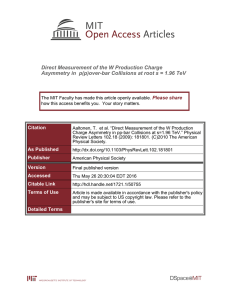
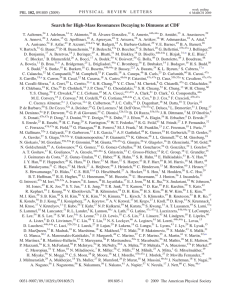

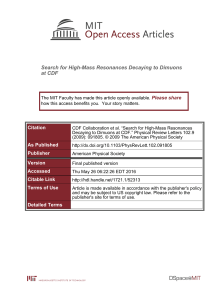
![Observation of Exclusive Charmonium Production and sqrt[s]=1.96 TeV](http://s2.studylib.net/store/data/012099626_1-e3cc2d249a0b30b56e2a5d794873df6b-300x300.png)

